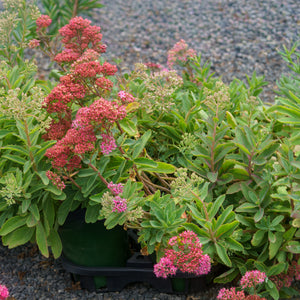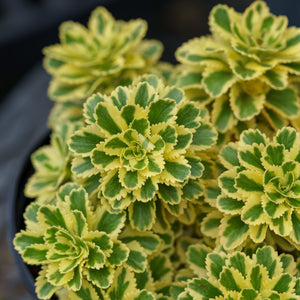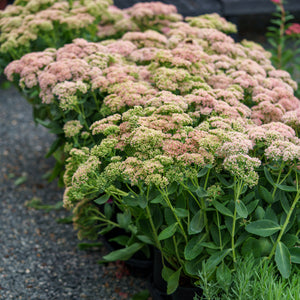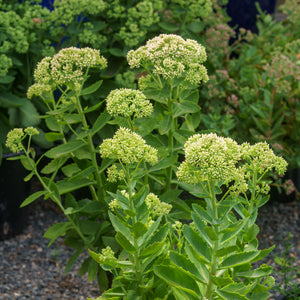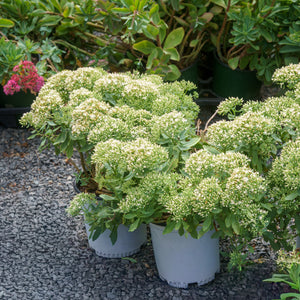The All-Purpose Power of Sedum: A Plant That Thrives Anywhere
When gardeners talk about reliability, few plants get as much respect as sedum. Also known as stonecrop, this plant family brings together an incredible range of varieties that thrive in heat, drought, and even neglected corners of the yard. From lush sedum ground covers that spill over rock walls to upright performers like Sedum ‘Autumn Joy’, there’s a sedum plant for every garden style.
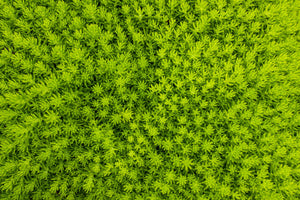
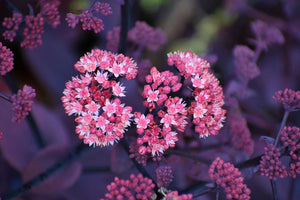
What is Sedum?
Sedum, commonly known as stonecrop, is a diverse genus of plants that belongs to the Crassulaceae family. With over 400 recognized species and countless hybrids and cultivars, sedum plants range from creeping groundcovers that hug the soil to upright, clump-forming perennials that command attention in late summer and fall. This wide diversity makes sedum one of the most versatile groups of plants available to home gardeners and landscapers alike.
At its core, sedum is a succulent. Its leaves are thick and fleshy, designed to store water, which gives the plant remarkable drought tolerance. This adaptation explains why sedum thrives in harsh, rocky environments where other plants struggle. The name “stonecrop” actually comes from this trait; it was often seen growing in the thinnest cracks of stone walls or in rocky outcrops, seemingly living on nothing more than stone itself.
Sedums are also valued for their multi-season interest. In spring and summer, their foliage creates lush mats or upright clusters in shades of green, gold, burgundy, or even variegated tones. As the season progresses, many upright sedums - like the popular Sedum ‘Autumn Joy’ - produce flower clusters that shift in color from pale green to pink, rose, and deep red as fall approaches. Creeping sedum varieties, such as Sedum ‘Angelina’ or Dragon’s Blood Sedum, add vibrant ground-level color that can change hues throughout the year, especially in cooler weather.
Another strength of sedum is its ecological value. The star-shaped flowers, often produced in large clusters, are a magnet for pollinators like bees and butterflies. Because sedum blooms late in the season, it provides a critical food source for pollinators when many other flowers have faded. Combined with its toughness, this makes sedum both a sustainable and wildlife-friendly choice for modern landscapes.
In short, sedum is not just another perennial, it’s a genus defined by adaptability, resilience, and diversity. Whether you need a sedum ground cover to replace turf, an upright performer like Autumn Joy for your borders, or a splash of gold from Sedum ‘Angelina,’ there’s a sedum variety ready to fit your vision.

Sedum Varieties Worth Knowing
With hundreds of sedum types in cultivation, it’s easy to get lost in the options. But here are some of the standout stonecrop varieties we carry, each with its own personality and use in the garden.
- Dark Magic Stonecrop – With deep burgundy foliage and clusters of soft pink flowers, this variety delivers dramatic color contrast, especially in sunny borders.
- Munstead Dark Red Stonecrop – A reliable upright sedum, prized for its rich dark red blooms that hold late into the season.
- Autumn Joy Stonecrop – Perhaps the most iconic sedum, Autumn Joy begins with green buds that mature to rose-pink and then deepen into russet tones by fall. A pollinator favorite.
- Autumn Fire Stonecrop – Similar to Autumn Joy but with stronger stems and denser flower heads, preventing the flopping that can happen late in the season.
- Wildfire Stonecrop – Known for its fiery foliage tones, this groundcover sedum adds flashes of red and orange throughout the growing season.
- Abbeydore Hybrid Stonecrop – A hybrid that combines durability with a long season of interest, producing compact growth and abundant pink blooms.
- Lime Twister Stonecrop – A standout for its variegated foliage, with bright lime green edged in creamy white, topped with soft pink flowers in summer.
- Angelina Stonecrop – A low-growing groundcover with vibrant golden-yellow foliage that shifts to orange hues in cooler weather, providing year-round color.
- Lime Zinger Stonecrop – A tidy, mat-forming sedum with bright green leaves rimmed in red, perfect for edging pathways or filling gaps.
- Firecracker Stonecrop – A compact sedum with bold, dark cherry foliage that holds its color all season and is topped with rosy-pink blooms.
- Class Act Stonecrop – Upright and showy, with deep green leaves and large heads of bright pink flowers that provide late-summer impact.
- Frosted Fire Stonecrop – Offers variegated foliage edged in creamy white, creating a striking look even before its pink blossoms appear.
- Dragon’s Blood Stonecrop – A classic groundcover sedum with rich red foliage and crimson blooms, one of the toughest and most colorful options available.
Each of these sedum varieties brings its own strengths, whether it’s the bold upright presence of Autumn Fire, the ground-hugging color of Angelina, or the fiery drama of Dragon’s Blood. Together, they showcase just how versatile the stonecrop family can be in gardens of any style or size.
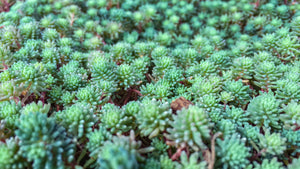
How to Use Sedum in the Landscape
One of sedum’s greatest strengths is its versatility. With so many sedum varieties - from spreading mats like Angelina Stonecrop to upright bloomers like Autumn Joy Stonecrop - there’s a role for this plant in every kind of garden. Here are some of the best ways to put sedum to work:
Ground Cover That Works Hard: Creeping forms such as Angelina Stonecrop, Lime Zinger Stonecrop, and Dragon’s Blood Stonecrop are ideal for creating living carpets. They fill in bare spots, choke out weeds, and handle tough sites where grass or more delicate plants would fail. Many of these sedum ground cover types even change foliage color with the seasons, offering year-round visual interest.
Borders, Edges, and Pathways: Low-growing sedums can be tucked along walkways, between stepping stones, or around patios. Their dense mats soften hardscapes and add vibrant texture at ground level. Varieties like Lime Twister Stonecrop and Frosted Fire Stonecrop offer foliage color that frames paths with a painterly touch.
Focal Points in the Garden: Taller sedums such as Autumn Fire Stonecrop or Class Act Stonecrop create bold structure in perennial beds. Their upright form and long-lasting blooms make them natural focal points, anchoring the garden when many summer flowers begin to fade. Plant them in drifts for a strong seasonal statement.
Containers and Mixed Plantings: Sedum plants thrive in pots, where they require little water and pair beautifully with other drought-tolerant species. Upright sedums can serve as the centerpiece in a container, while creeping sedums spill attractively over the edges. A container with Firecracker Stonecrop spilling down the sides is an easy way to add drama to a patio display.
Rock Gardens and Slopes: True to their stonecrop name, sedums excel in rocky, shallow soils. They’re perfect for rock gardens, crevices, and retaining walls, where they root easily and cascade over edges. On slopes, creeping sedums double as erosion control, creating a durable and colorful groundcover solution.
Pollinator Powerhouses: Upright varieties like Autumn Joy Stonecrop and Munstead Dark Red Stonecrop are pollinator magnets. By blooming late in the season, they provide crucial nectar when other plants are shutting down for the year. Use them near vegetable gardens or orchards to attract beneficial pollinators.
Sustainable Landscaping: Sedums have become a staple of green roofs and eco-friendly plantings. Their ability to withstand heat, drought, and shallow soils makes them ideal for reducing stormwater runoff and cooling rooftops naturally. Even if you’re not planting a roof, sedum is an easy choice for low-water, low-maintenance garden design.
Whether you’re after bold color, sustainable solutions, or a reliable filler between flagstones, sedum can handle the job. Few plants offer such a wide range of applications with so little demand in return.
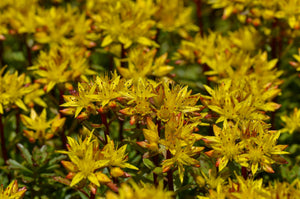
Growing and Caring for Sedum
Part of sedum’s charm is that it doesn’t ask for much. Once planted, most varieties thrive with minimal effort, making them ideal for both beginners and seasoned gardeners who want low-maintenance impact. That said, a few simple guidelines will help you get the very best out of your sedum plants.
Sunlight: Sedum performs best in full sun, where its foliage develops the richest color and its flowers bloom most abundantly. Groundcover types such as Angelina Stonecrop take on fiery tones in cool weather when grown in strong light. While sedum can tolerate partial shade, too much shade often leads to weaker stems, fewer blooms, and less vibrant color.
Soil Requirements: The number-one rule with sedum is well-drained soil. Because these plants store water in their leaves, they’re highly susceptible to root rot in soggy conditions. Sandy or gravelly soil is ideal, though sedum will adapt to most soil types as long as they don’t stay wet for long periods. Planting sedum in raised beds, rock gardens, or along slopes can naturally improve drainage.
Watering: Once established, sedum is exceptionally drought tolerant. Water deeply after planting to encourage root development, then step back. In most climates, natural rainfall is sufficient. Overwatering is one of the few ways to harm a sedum plant. If you’re unsure, remember: less is better.
Fertilization: Sedum generally doesn’t require fertilizer. Too much nutrition can actually cause floppy, weak growth, especially in upright varieties like Autumn Joy Stonecrop and Autumn Fire Stonecrop. If your soil is extremely poor, a light application of a balanced, slow-release fertilizer in spring is sufficient.
Pruning and Maintenance:
- Upright Sedums: In early spring, cut back last year’s stems to make way for new growth. After blooming, you can leave the dried flower heads for winter interest, as they hold up beautifully under frost and snow.
- Creeping Sedums: If they spread beyond their intended space, simply prune them back. They respond well to trimming and will quickly fill in again.
Dividing and Replanting: Sedums are easy to divide. Every few years, clumps of upright varieties can be split in spring or fall to rejuvenate growth and create new plants. Creeping sedums can be propagated even more simply: snip a piece, set it on soil, and it will often root on its own.
Winter Care: Most sedum stonecrop varieties are cold hardy and require no protection in winter. In fact, many upright sedums provide structure and beauty in the dormant season, with dried flower clusters dusted in snow. Creeping sedums go dormant but bounce back reliably in spring.
Pests and Problems: Sedum is remarkably pest-free. Occasionally, aphids may appear on flower clusters, but they rarely cause serious damage. The biggest threat comes from overwatering or heavy, waterlogged soils. Plant sedum where drainage is strong, and you’ll avoid almost all problems.
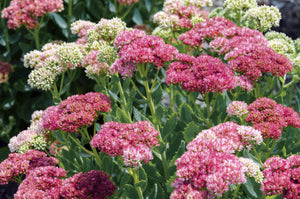
Why Sedum Belongs in Every Garden
When it comes to dependable plants, sedum is in a class of its own. Few perennials manage to check so many boxes at once: tough, colorful, low-maintenance, and endlessly adaptable. Whether you’re filling gaps in a stone wall, designing a pollinator-friendly border, or experimenting with sustainable landscaping, sedum delivers without fuss.
The appeal of sedum comes down to three key traits:
Reliability: Once established, sedum takes care of itself. It doesn’t wilt in heat, doesn’t demand constant watering, and thrives in soil conditions that would defeat fussier plants.
Versatility: With options ranging from upright performers like Autumn Fire Stonecrop to creeping ground covers like Dragon’s Blood Stonecrop, there’s a sedum for every design style. It can be the centerpiece of a border, a carpet underfoot, or the splash of gold and red that ties a planting together.
Seasonal Value: Sedum offers year-round interest. Foliage color shifts through the seasons, blooms arrive late when the garden needs them most, and dried seed heads stand tall through winter. Few plants play such a long game.
But sedum’s true strength is how it makes gardening simpler. Plant it once, and it rewards you year after year with color and structure, often improving with age. It’s equally at home in a carefully designed border as it is thriving in the cracks of a stone path.
If your garden needs a reliable workhorse that also knows how to put on a show, sedum is the plant to choose. From 'Wildfire' to 'Lime Twister' to 'Firecracker', each variety brings something different to the table, yet all share the same dependable nature. Sedum doesn’t just survive; it thrives, adding beauty, resilience, and character to any space.
In the end, that’s why sedum belongs in every garden: it’s the plant you can count on, season after season, to deliver beauty without demanding much in return.
Our Sedum Collection
Sold Out

